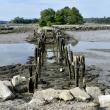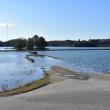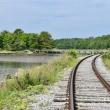Forsaken White’s Island
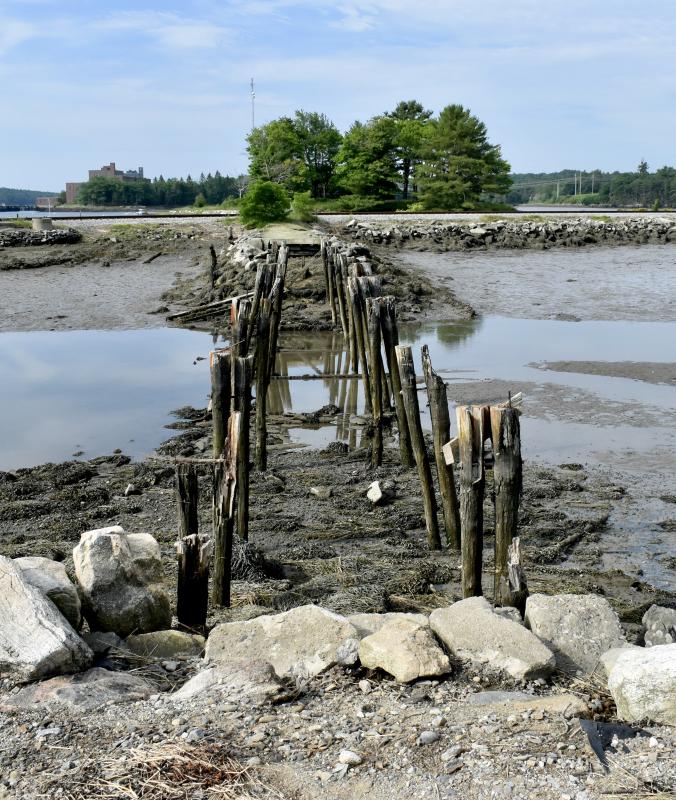 Public Works recently removed the decking of the footbridge closest to the shore leaving only its pilings behind many of which are rot and worm damage. PHIL DIVECE/Wiscasset Newspaper
Public Works recently removed the decking of the footbridge closest to the shore leaving only its pilings behind many of which are rot and worm damage. PHIL DIVECE/Wiscasset Newspaper
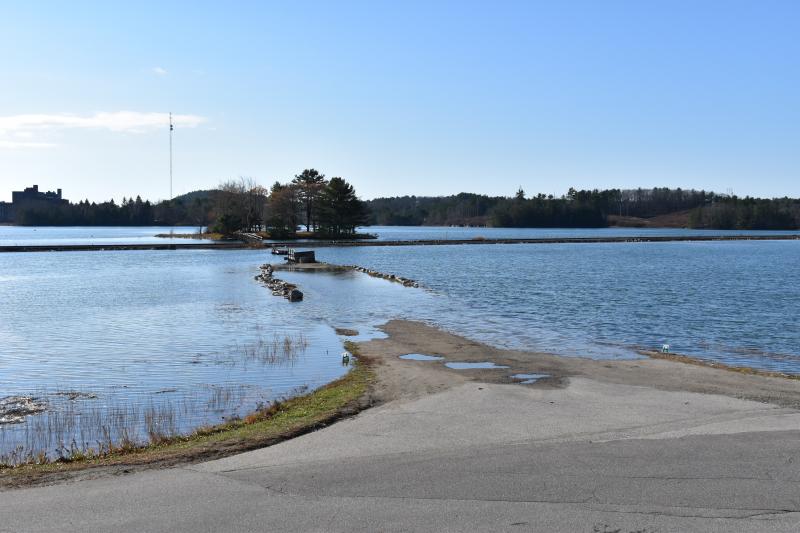 Flood tides like this one enveloping the causeway leading White’s Island on the Wiscasset waterfront are apt to occur during storm surges in the spring and fall. PHIL DI VECE/Wiscasset Newspaper
Flood tides like this one enveloping the causeway leading White’s Island on the Wiscasset waterfront are apt to occur during storm surges in the spring and fall. PHIL DI VECE/Wiscasset Newspaper
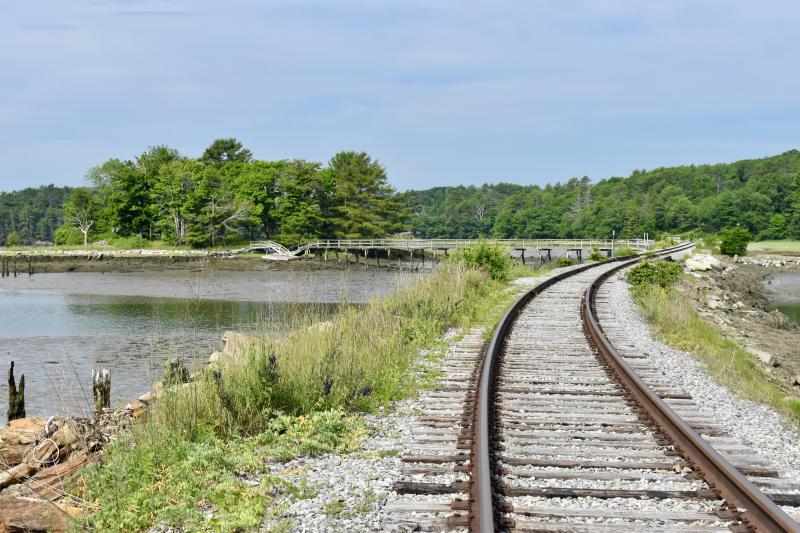 Shown is the remaining footbridge. White’s Island can be seen on the left. The end of the footbridge has collapsed. It is illegal to walk on the railroad tracks to reach the footbridge; MRSA Title 23 subsection 7007 (Safety Railroad Provisions) states, walking or riding on any active railroad right of way is trespassing and subject to prosecution. PHIL DI VECE/Wiscasset Newspaper
Shown is the remaining footbridge. White’s Island can be seen on the left. The end of the footbridge has collapsed. It is illegal to walk on the railroad tracks to reach the footbridge; MRSA Title 23 subsection 7007 (Safety Railroad Provisions) states, walking or riding on any active railroad right of way is trespassing and subject to prosecution. PHIL DI VECE/Wiscasset Newspaper
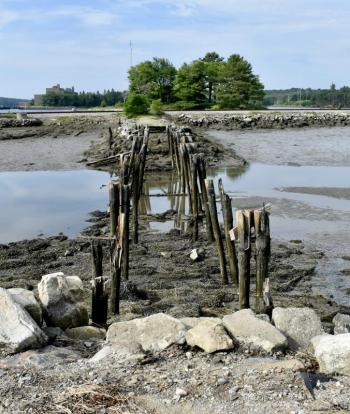 Public Works recently removed the decking of the footbridge closest to the shore leaving only its pilings behind many of which are rot and worm damage. PHIL DIVECE/Wiscasset Newspaper
Public Works recently removed the decking of the footbridge closest to the shore leaving only its pilings behind many of which are rot and worm damage. PHIL DIVECE/Wiscasset Newspaper
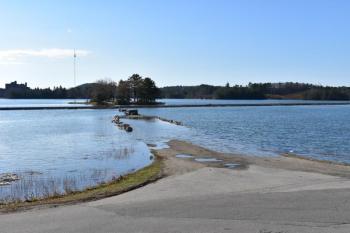 Flood tides like this one enveloping the causeway leading White’s Island on the Wiscasset waterfront are apt to occur during storm surges in the spring and fall. PHIL DI VECE/Wiscasset Newspaper
Flood tides like this one enveloping the causeway leading White’s Island on the Wiscasset waterfront are apt to occur during storm surges in the spring and fall. PHIL DI VECE/Wiscasset Newspaper
 Shown is the remaining footbridge. White’s Island can be seen on the left. The end of the footbridge has collapsed. It is illegal to walk on the railroad tracks to reach the footbridge; MRSA Title 23 subsection 7007 (Safety Railroad Provisions) states, walking or riding on any active railroad right of way is trespassing and subject to prosecution. PHIL DI VECE/Wiscasset Newspaper
Shown is the remaining footbridge. White’s Island can be seen on the left. The end of the footbridge has collapsed. It is illegal to walk on the railroad tracks to reach the footbridge; MRSA Title 23 subsection 7007 (Safety Railroad Provisions) states, walking or riding on any active railroad right of way is trespassing and subject to prosecution. PHIL DI VECE/Wiscasset Newspaper
There is no shortage of suggestions on what to do with Wiscasset’s White’s Island, which probably means nothing will happen, at least not in the foreseeable future. I could have told you this was the way it was going to be. But let’s take a moment to look back and see how we got here and, who knows, maybe the community will come to some form of consensus.
It’s been 20 years since people have been able to walk out safely to White’s Island across two timber pile footbridges. Just one bridge remains; in the spring the town’s public works department removed the footbridge closest to the shore leaving only rows of rotting piling to mark its path. Both footbridges were built in 1980 and had been pretty well-maintained until the late 1990s. But by about 2010 they needed more than just routine repairs; there were some serious structural issues. Nothing was done to address the problems and a year or so later the bridges were closed. This was done in short because town officials were unable to reach an agreement with the island’s owner on who was responsible for the footbridges.
The one-acre island had always been privately owned from the time the town was founded. It didn’t become publicly owned until 2016 when the town assumed ownership after finalizing an agreement with Maine Coast Heritage Trust, a non-profit group with its main office in Topsham. The agreement with MCHT stipulated the island be kept in its natural state and open to the public for daytime, low-impact recreational use.
For most of the 19th century it was owned by several individuals, among them the Hobson family who operated a large wood manufacturing mill here. This was also when a separate, much longer wooden bridge on the island’s southern shore connected it with Birch Point. Later, in the 1930s and 1940s the island was home to Pendleton Boat Yard where the schooner When and If was built for General George Patton.
The custom of allowing folks to visit the island started after Richmond White bought it. White resided with his family in the mansion near the corner of High and Lee streets. He could see the island which bears his family name from his parlor. White built two bathhouses on the island’s eastern side and erected a small pier reserving this side for swimming, cookouts and other activities for his family and guests. Residents of Wiscasset, however, were free to use the island, too, and could swim in the small cove on the opposite side of the island.
When I first came to Wiscasset in 1978, Margaret White Stetson, a daughter of Richmond White, owned the island. Mrs. Stetson continued the tradition of keeping the island open to the public and it became a popular place for people to swim, fish, walk their dog and have a picnic. The town of Wiscasset was flush with money then thanks to the property tax revenues provided by the Maine Yankee nuclear plant and the oil-fired Mason Station generating station owned by Central Maine Power Co. Together the two power plants provided about 96 cents of every tax dollar raised by the town. Needless to say, in 1980 not many people complained about the town picking up the tab for building two new footbridges to a privately owned island. Together the bridges cost $40,000, which sounds like a bargain until you consider that’s the equivalent of roughly $141,891 today! Something else I should mention is they were designed by Wiscasset’s own town engineer.
The biggest problem with timber pile bridges is the cost of maintaining them. No matter how well-maintained they are, over time the wooden decking and railing warp and eventually rot. The footbridge’s piling fell victim to time, tide and marine terradoes, more commonly called, “ship worms” that bore into the wood and gradually weaken it. This was the same problem which forced the state to replace the former Route 1 timber pile bridge linking Wiscasset to Edgecomb; terradoes had hollowed out something like a third of its pilings.
If Wiscasset is serious about replacing the White’s Island footbridges, they should consider freestanding metal structures. These would have to be custom made and arched high enough to overcome extreme high tides. During the spring and fall, tidal water sometimes surrounded the first footbridge damaging its support structure and eroding its embankments. The new bridges will also need to be Americans with Disabilities Act (ADA)-compliant in order to get grant monies. I haven’t mentioned the causeway from Fore Street leading to the bridges. This fill was placed here by the town in the 1980s during reconstruction of the village streets. Up until a few years ago the causeway had never flooded but as you can see from the picture taken by me last fall that’s no longer the case.
In 2018, I helped write a grant seeking matching funds from Maine Department of Land & Water Conservation. My idea was to do a White’s Island project similar to the way the town of Woolwich developed Nequasset Park, that is, in phases over three to five years as monies became available. Phase one was to use grant monies to hire an engineering firm to design the footbridges and abutments, assist with obtaining the permitting and develop a plan where the footpath crosses the railroad tracks. Unfortunately, the grant was never submitted and nothing’s been done since until this past year when Wiscasset Parks and Recreation began its effort.
The recently held White’s Island informational meeting drew a sizable turnout indicating people care about what does or doesn’t happen. It’ll be interesting to see results of the park and rec questionnaire. If you’d like to take part in the survey, copies are available at the front desk of Wiscasset Community Center. In the meantime, something has to be done about the remaining footbridge which should be removed ASAP before someone hurts themselves trying to cross it and then sues the town. White’s Island remains open to the public but should only be visited by boat. There’s a natural landing on the western shore which faces Castle Tucker. And, just a friendly reminder, state law forbids people from walking over the railroad tracks, the only other way of reaching the footbridge.
At the informational meeting, someone pointed out the money it would take to replace the footbridges and make other improvements to the island and causeway might be better spent by parks and rec to buy kayaks, paddle boards and canoes, the idea being these could be rented and people could paddle around the harbor and over to White’s Island. Others just want new footbridges built. Some say the best thing is to do nothing and let the island return to its natural state. What do you think?
Phil Di Vece earned a bachelor of arts in journalism studies from Colorado State University and a master of arts in journalism at the University of South Florida. He is the author of three Wiscasset books and is a frequent news contributor to the Wiscasset Newspaper and Boothbay Register. He resides in Wiscasset. Contact him at pdivece@roadrunner.com




